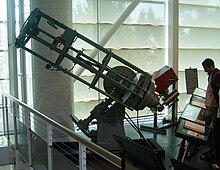The latest one technology-wise -
The last three-mirror anastigmat [LTA]
A three-mirror anastigmat is an anastigmat telescope built with three curved mirrors, enabling it to minimize all three main optical aberrations – spherical aberration, coma, and astigmatism. This is primarily used to enable wide fields of view, much larger than possible with telescopes with just one or two curved surfaces.
A telescope with only one curved mirror, such as a Newtonian telescope, will always have aberrations. If the mirror is spherical, it will suffer from spherical aberration. If the mirror is made parabolic, to correct the spherical aberration, then it must necessarily suffer from coma and off-axis astigmatism. With two curved mirrors, such as the Ritchey–Chrétien telescope, coma can be eliminated as well. This allows a larger useful field of view, and the remaining astigmatism is symmetrical around the distorted objects, allowing astrometry across the wide field of view. However, the astigmatism can be cancelled by including a third curved optical element. When this element is a mirror, the result is a three-mirror anastigmat. In practice, the design may also include any number of flat fold mirrors, used to bend the optical path into more convenient configurations.

The latest one was followed by RC telescope
Ritchey–Chrétien telescope
A Ritchey-Chrétien telescope (RCT or simply RC) is a specialized variant of the Cassegrain telescope that has a hyperbolic primary mirror and a hyperbolic secondary mirror designed to eliminate off-axis optical errors (coma). The RCT has a wider field of view free of optical errors compared to a more traditional reflecting telescope configuration. Since the mid 20th century, a majority of large professional research telescopes have been Ritchey-Chrétien configurations; some well-known examples are the Hubble Space Telescope, the Keck telescopes and the ESO Very Large Telescope.

The RC telescope was followed by
Cassegrain reflector
The Cassegrain reflector is a combination of a primary concave mirror and a secondary convex mirror, often used in optical telescopes and radio antennas, the main characteristic being that the optical path folds back onto itself, relative to the optical system's primary mirror entrance aperture. This design puts the focal point at a convenient location behind the primary mirror and the convex secondary adds a telephoto effect creating a much longer focal length in a mechanically short system.[1]
In a symmetrical Cassegrain both mirrors are aligned about the optical axis, and the primary mirror usually contains a hole in the centre, thus permitting the light to reach an eyepiece, a camera, or an image sensor. Alternatively, as in many radio telescopes, the final focus may be in front of the primary. In an asymmetrical Cassegrain, the mirror(s) may be tilted to avoid obscuration of the primary or to avoid the need for a hole in the primary mirror (or both).
The classic Cassegrain configuration uses a parabolic reflector as the primary while the secondary mirror is hyperbolic.[2] Modern variants may have a hyperbolic primary for increased performance (for example, the Ritchey–Chrétien design); and either or both mirrors may be spherical or elliptical for ease of manufacturing.
The Cassegrain reflector is named after a published reflecting telescope design that appeared in the April 25, 1672 Journal des sçavans which has been attributed to Laurent Cassegrain.[3] Similar designs using convex secondaries have been found in the Bonaventura Cavalieri's 1632 writings describing burning mirrors[4][5] and Marin Mersenne's 1636 writings describing telescope designs.[6] James Gregory's 1662 attempts to create a reflecting telescope included a Cassegrain configuration, judging by a convex secondary mirror found among his experiments.[7]
The major difference between all three generation of telescope is error correction
Mainly, errors are consisting of different type of abberation i.e. Astigmatism(Spherical, parabolic, etc.), Coma, etc.
We will see type of error as well, here.
We will see type of error as well, here.
Spherical aberration
Spherical aberration is a type of aberration found in optical systems that use elements with spherical surfaces. Lenses and curved mirrors are most often made with surfaces that are spherical, because this shape is easier to form than non-spherical curved surfaces. Light rays that strike a spherical surface off-centre are refracted or reflected more or less than those that strike close to the centre. This deviation reduces the quality of images produced by optical systems.

GSAT-29, Indian satellite launched in December 2018, is consisting of imaging payload which is known as GHRC- GEO High-resolution camera, is using RC type telescope for imaging.
Source:
Wikipedia
